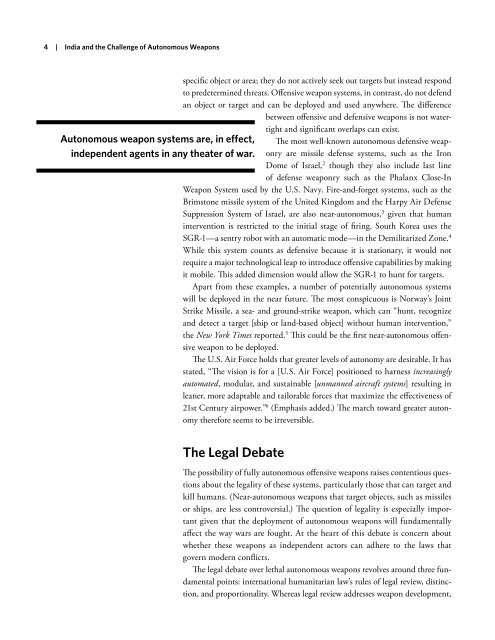INDIA AND THE CHALLENGE OF AUTONOMOUS WEAPONS
CEIP_CP275_Reddy_final
CEIP_CP275_Reddy_final
You also want an ePaper? Increase the reach of your titles
YUMPU automatically turns print PDFs into web optimized ePapers that Google loves.
4 | India and the Challenge of Autonomous Weapons<br />
specific object or area; they do not actively seek out targets but instead respond<br />
to predetermined threats. Offensive weapon systems, in contrast, do not defend<br />
an object or target and can be deployed and used anywhere. The difference<br />
between offensive and defensive weapons is not watertight<br />
and significant overlaps can exist.<br />
Autonomous weapon systems are, in effect, The most well-known autonomous defensive weaponry<br />
are missile defense systems, such as the Iron<br />
independent agents in any theater of war.<br />
Dome of Israel, 2 though they also include last line<br />
of defense weaponry such as the Phalanx Close-In<br />
Weapon System used by the U.S. Navy. Fire-and-forget systems, such as the<br />
Brimstone missile system of the United Kingdom and the Harpy Air Defense<br />
Suppression System of Israel, are also near-autonomous, 3 given that human<br />
intervention is restricted to the initial stage of firing. South Korea uses the<br />
SGR-1—a sentry robot with an automatic mode—in the Demilitarized Zone. 4<br />
While this system counts as defensive because it is stationary, it would not<br />
require a major technological leap to introduce offensive capabilities by making<br />
it mobile. This added dimension would allow the SGR-1 to hunt for targets.<br />
Apart from these examples, a number of potentially autonomous systems<br />
will be deployed in the near future. The most conspicuous is Norway’s Joint<br />
Strike Missile, a sea- and ground-strike weapon, which can “hunt, recognize<br />
and detect a target [ship or land-based object] without human intervention,”<br />
the New York Times reported. 5 This could be the first near-autonomous offensive<br />
weapon to be deployed.<br />
The U.S. Air Force holds that greater levels of autonomy are desirable. It has<br />
stated, “The vision is for a [U.S. Air Force] positioned to harness increasingly<br />
automated, modular, and sustainable [unmanned aircraft systems] resulting in<br />
leaner, more adaptable and tailorable forces that maximize the effectiveness of<br />
21st Century airpower.” 6 (Emphasis added.) The march toward greater autonomy<br />
therefore seems to be irreversible.<br />
The Legal Debate<br />
The possibility of fully autonomous offensive weapons raises contentious questions<br />
about the legality of these systems, particularly those that can target and<br />
kill humans. (Near-autonomous weapons that target objects, such as missiles<br />
or ships, are less controversial.) The question of legality is especially important<br />
given that the deployment of autonomous weapons will fundamentally<br />
affect the way wars are fought. At the heart of this debate is concern about<br />
whether these weapons as independent actors can adhere to the laws that<br />
govern modern conflicts.<br />
The legal debate over lethal autonomous weapons revolves around three fundamental<br />
points: international humanitarian law’s rules of legal review, distinction,<br />
and proportionality. Whereas legal review addresses weapon development,





